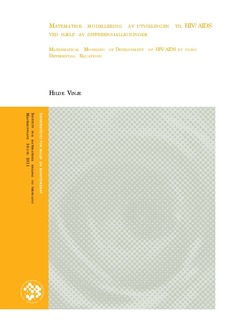| dc.contributor.advisor | Ponossov, Arkadi | |
| dc.contributor.author | Vinje, Hilde | |
| dc.date.accessioned | 2011-10-07T09:11:03Z | |
| dc.date.available | 2011-10-07T09:11:03Z | |
| dc.date.copyright | 2011 | |
| dc.date.issued | 2011-10-07 | |
| dc.identifier.uri | http://hdl.handle.net/11250/188700 | |
| dc.description.abstract | HIV/AIDS har vært en av de største bekymringene til helsevesenet i moderne historie og er fremdeles, 30 år etter sin oppdagelse, en av de største helsebekymringene i samfunnet. Det har, naturlig nok, blitt utformet mange matematiske modeller, med forskjellig innfallsvinkler og antagelser for å beskrive epidemien HIV/AIDS. I denne oppgaven tar jeg utgangspunkt i en allerede etablert matematisk modell, bestående av et system av ordinære differensialligninger, for så å innføre en tidsforsinkelse for å gjøre systemet mer realistisk. Jeg bruker modellen Kgosimore og Lungu kom frem til i sin artikkel [5]. De har i denne artikkelen etablert en teoretisk modell for seksuelt overførbar HIV/AIDS som også involverer vaksinering av mottakelige individer og behandling av HIV-positive.
Jeg diskuterer rundt modellen og kommer frem til at den blir mer reell ved å innføre en distribuert tidsforsinkelse med hensyn på kjønnsmodningsperioden. Siden systemet kun omfatter den seksuelle overføringen av sykdommen, antar jeg at ingen blir født smittede. Denne tidsforsinkelsen blir derfor innført i gruppene av de som er mottakelige. Videre benytter jeg metoden "Linear Chain trick" for å gjøre systemet, bestående av seks differensialligninger med en tidsforsinkelse, til et system med åtte ordinære differensialligninger uten tidsforsinkelse.
I Kgosimore og Lungu's artikkel [5] l ser de systemet analytisk. Siden dette blir en umulig oppgave etter innføringen av tidsforsinkelser, velger jeg å løse mitt problem numerisk. Jeg innfører dermed reelle verdier for parametrene, for å gjennomføre en numerisk stabilitetsanalyse. Siden jeg allerede har en del informasjon om stabilitetsegenskapene til systemet uten tidsforsinkelse fra artikkelen til Kgosimore og Lungu, tester jeg mine numeriske resultater opp mot teorien de har kommet frem til. Jeg fant ut at man ikke kan bruke den analytiske løsningen og teorien til modellen for å teste modellen. Modelltesting er noe annet enn teori og jeg peker på flere bevis som viser dette. Jeg konkluderer videre med at teorien i Kgosimore og Lungu's artikkel [5] kan brukes til å trekke konklusjon med, men for a oppnå dette måtte jeg ta en del urealistiske antagelser og resultatene bør sjekkes eksplisitt.
I siste del av oppgaven gjennomfører jeg selv en stabilitetsanalyse på systemet med en tidsforsinkelse og finner ut at stabilitetsegenskapene til systemet blir bedre etter innføringen av denne. Konklusjonen blir da at modellen både blir mer realistisk og mer robust ved innføringen av denne tidsforsinkelsen. | en_US |
| dc.description.abstract | HIV/AIDS has been one of the biggest health issues in modern history. It is still, 30 years after its discovery, one of the biggest health challenges we face. Naturally, it has been designed a plethora of mathematical models, with different approaches and assumptions to describe the epidemic HIV/AIDS. This thesis takes its out spring in an already established model, which involves a system of ordinary differential equation. I then introduce a delay in this model, to make it more realistic. The model I used was the model that Kgosimore and Lungu established in their article [5]. This is a theoretical model for sexual transmitted HIV/AIDS that also involves vaccination of susceptible individual and treatment of HIV/AIDS positive individuals.
I discuss the model and conclude that it will appear more realistic if I introduced a distributed delay in the maturation period. Since the system only deals with the sexual transmittance of the disease, I make the assumption that nobody is born infected. Because of this assumption I incorporate the delay in the groups of susceptible. I then use the method of Linear Chain trick to convert the system of six di erential equations with a delay, into a system of eight ordinary di erential equations without a delay.
In Kgosimore and Lungus article [5] they solve the system analytical. Since this is an impossible task after the delay is incorporated, I choose to solve the problem numerically. I then introduce real values for the parameters in the model to complete a numerical stability analysis. Since I already have some information about the stability properties for the system without the delay from Kgosimore and Lungus article, I start by testing my numerical results against the theory from the analytical solution. From this analysis I found out that the analytical solutions and the theory described in the article could not be used to test the model. Model testing is di erent from theory and I have employed several proofs to show this. I also conclude that the theory found in Kgosimore and Lungus article [5] can be used to draw conclusions, but to gain this result I had to take some unrealistic assumptions and the results must be checked explicitly.
In the last part of the thesis I completed a stability analysis on the system with an incorporated delay. The analysis reveals that the stability properties have been improved after incorporating a delay in the system. The conclusion is that the model has become more realistic and more robust when the delay is incorporated. | |
| dc.language.iso | nob | en_US |
| dc.publisher | Norwegian University of Life Sciences, Ås | |
| dc.subject | HIV/AIDS | en_US |
| dc.subject | Differensialligninger med delay | en_US |
| dc.title | Matematisk modellering av utviklingen til HIV/AIDS ved hjelp av differensialligninger | en_US |
| dc.title.alternative | Mathematical modeling of development of HIV/AIDS by using differential equations | en_US |
| dc.type | Master thesis | en_US |
| dc.subject.nsi | VDP::Mathematics and natural science: 400::Mathematics: 410::Applied mathematics: 413 | en_US |
| dc.source.pagenumber | 99 | en_US |
| dc.description.localcode | M-LUN | |
